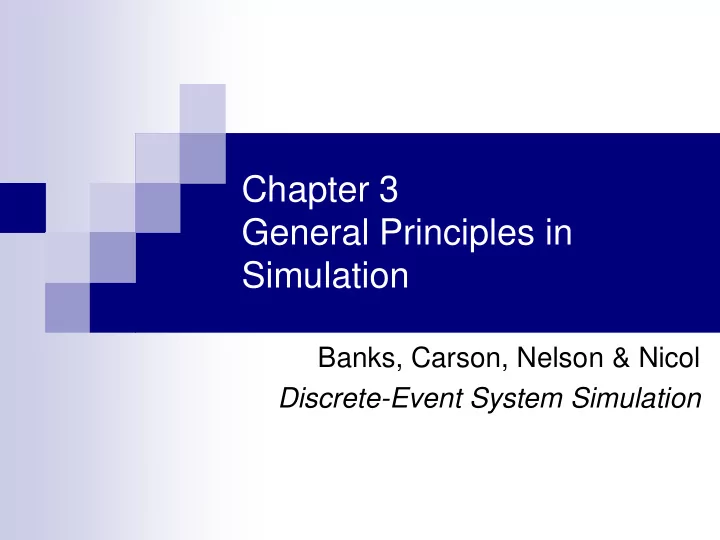

Chapter 3 General Principles in Simulation Banks, Carson, Nelson & Nicol Discrete-Event System Simulation
Outlines Concepts In Discrete-Event Simulation Able-Baker call center (an example) Event scheduling Event scheduling example 2
Concepts In Discrete-Event Simulation System A collection of entities (people and machines..) that interact together over time for one or more goals Model An abstract representation of a system, usually containing structural, logical or mathematical relationship that describe a system in term of state, entities and their attributes , sets, processes,… System state A collection of variables in any time that describe the system Entity Any object or component in system that require explicit representation (server, customer,...) Attributes The properties of a given customer List A collection of associated entities , ordered in some logical fashion (FIFO, priority,…) 3
Concepts In Discrete-Event Simulation (cont.) Event An instantaneous occurrence that changes the state of a system Event Notice A record of an event to occur at the current or future time (type and time) Event List FEL (future event list) Activity (unconditional wait) A duration time of specified length (service time or interarrival time,… ) Deterministic, Statistical and functional Delay (conditional wait) A duration of time of unspecified indefinite length, which is not known until it ends (customer delay in waiting line) Clock A variable representing simulated time 4
Able-Baker Call center System state LQ(t): the number of callers waiting to serve LA(t):0 or 1 indicate Able is idle or busy LB(t):0 or 1 indicate Baker is idle or busy Entities Caller Events Arrival event, service completion by Able or Baker Activities Service time by Able/Baker and Inter-arrival time Delay A caller wait in queue until Able or Baker becomes free 5
Event scheduling How does each event affect system state, attributes? How activities are defined (deterministic, probabilistic ,…)? Which events trigger the beginning of each delay? What is system state at time 0? 6
Event scheduling (cont.) t1<t2<…< tn FEL is ordered by event time 7
Event scheduling/Time-advance algorithm 8
Generation Arrival Stream by Bootstrapping 9
Two customer processes interaction in single server queue 10
The stop time of simulation At time 0 the simulation stop time is specified, T E Run length T E is determined by the simulation itself. The time of occurrence of some specified events 11
Event Scheduling example (Grocery Center) System State LQ(t),LS(t) Entities The server and customer are not explicitly modeled Events Arrival (A), Departure (D), Stopping event (E=60) Event notices (A,t), (D,t) , (E,60) Activities Inter-arrival time, service time Delay Customer time spent in waiting queue 12
Execution of the arrival event
Execution of the departure event 14
Simulation Table 15
Computing Mean Response Time (cont.) Entities (Ci,t), representing customer Ci who arrives at time t Event notices (A,t,Ci), the arrival of customer Ci at future time t (D,t,Cj), the departure of customer Cj at future time t Set “CHECKOUT LINE” the set of all customers currently at the checkout counter, ordered by time of arrival Response time CLOCK TIME- attribute “time of arrival” S:sum of customer response time ND: all number of customers that currently are departure F:Total number of customers that spend more than 5 minutes in system 16
Simulation Table 17
Structure of a simulation system 18
Recommend
More recommend